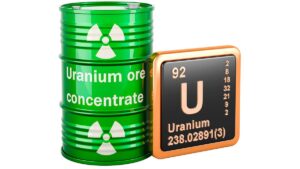Small Cap Recap and IPO Wrap: Risk suddenly feels awful risky

Via Getty
The ASX 200 ended last week slipping further into the red with local shares shedding circa -1.5% of puppy fat by the end of the day and around -2% for the week. That’s after the benchmark ASX200 gave away over ~200 points in the last three sessions.
Aussie stocks have now fallen to depths of shame not seen in three months after Friday’s misery. April, I find, is a typically deplorable month.
As Stockhead’s majestic student of rate-sensitive sectors, Eddy Sunarto,
pointed out on the day, all 11 local sectors lost points with Tech, Real Estate and Discretionary stocks just a delight for traders to sell.
ASX Sectors Weekly Performance

The Wall Street lead was weakened by happy-happy, strong-strong US jobs data which is great if you need one, shite if you’re banking against more of the fulsome rate hikes that the US Fed looks comfy with.
The private sector added almost half a million jobs in June, which took a stick to overpaid and under-shooting US economists. They predicted less than half of that, and estimating an average 228,000 jobs is nothing less than a waste of my time and your money.
“The data-dependent Fed will look at the labour market and that should support the case for much more tightening,” OANDA’s top analyst Edward Moya told Eddy on Friday.
The coalescence of dark moods and ill indicators came to fruition in ripening bond yields overnight.
The stronger than expected jobs data pushed Aussie bond yields higher, with 1-year Guvvie yield jumping by 9bp and 10yr by 10bp, while for the week, bond yields rose sharply on the back of the now baked in looking higher-for-longer rate expectations with the Australian 10-year heaving heavenward to its highest sin a decade.
The local 10-year yield jumped 15bps/~3.5% at the open, but rose to 4.255% as risk-on traders took the arvo off. There was certainly little investor appetite to add fuel to uncertain exposures on Friday. Risk suddenly felt awfully risky.
The local bond futures market is also pricing in more tightening from the RBA.
Oil prices rose on the back of Saudi Arabia saying it will extend its production cuts into August and Russia saying it will cut its oil exports. Metal prices fell but iron ore prices rose slightly.
After a strong run in June and over the last financial year, global equities remain vulnerable to a pull back, says Dr Shane Oliver.
One of the unsung challenges facing local markets – and beyond – is the more than 25% dive in global commodity prices in the last year of white-anting prices.
The S&P GSCI Commodities index takes a basket of the wider performance of various commodity markets and smooshes them into an index of sorts.

Out of the different baskets of commodities, industrial metals are short -3.8% for the year to June 30, while energy commodities like oil and gas have retreated from fab highs by a pretty fab 21%.
On the plus side for Aussie farmers, agri-commodities including grains, wheats and sugar are up well into double digits.
How did this week’s IPOs perform?
Chemicals distributor Redox’s (ASX:RDX) $1.3 billion IPO listing on Monday was the biggest to strike an unsuspecting ASX since infrastructure stock Ventia Services’ (ASX:VNT) listed in November 2021.
But it wasn’t a day early Redox investors had hoped for, with the share price closing the session -5% below the IPO price.
Redox was founded in 1965 by Roland Coneliano in Minto, NSW.
Coneliano and his family have grown the company into the biggest supplier of chemicals for crop protection, food and beverage, and the plastics industries.
The other local debutant this week was Australian Critical Minerals (ASX:ACM).
The ACM share price is currently trading at 21c, higher than its IPO price of 20c.
The junior explorer has a multiple mineral-exploration strategy focussed on lithium and REE. The company has six project areas across an impressive 1,861km2 of prospective tenements in the Tier-1 mining jurisdiction of Western Australia.
ASX SMALL CAP WINNERS:
Here are the best performing ASX small cap stocks
Swipe or scroll to reveal full table. Click headings to sort:
| Code | Company | Price | % Week | Market Cap |
|---|---|---|---|---|
| LDX | Lumos Diagnostics | 0.086 | 760% | 29319126.9 |
| MTB | Mount Burgess Mining | 0.005 | 233% | 4415855.6 |
| AUZ | Australian Mines Ltd | 0.035 | 169% | 24849072.7 |
| AT1 | Atomo Diagnostics | 0.056 | 155% | 30828113.5 |
| RCW | Rightcrowd | 0.03 | 150% | 7895754.48 |
| OPL | Opyl Limited | 0.042 | 133% | 2962407.41 |
| TMB | Tambourahmetals | 0.225 | 130% | 5972926.71 |
| AYT | Austin Metals Ltd | 0.009 | 125% | 7111122.59 |
| PEB | Pacific Edge | 0.18 | 125% | 137762087 |
| CAV | Carnavale Resources | 0.006 | 100% | 13667758.6 |
| DXN | DXN Limited | 0.002 | 100% | 3442629.67 |
| ARL | Ardea Resources Ltd | 0.63 | 97% | 122904762 |
| KAI | Kairos Minerals Ltd | 0.0305 | 86% | 61154617.7 |
| GED | Golden Deeps | 0.011 | 83% | 8086587 |
| RGS | Regeneus Ltd | 0.012 | 71% | 5209427.54 |
| KTA | Krakatoa Resources | 0.041 | 71% | 14898439.9 |
| ENT | Enterprise Metals | 0.005 | 67% | 3647354.66 |
| NNG | Nexion Group | 0.02 | 67% | 3236925.66 |
| TKL | Traka Resources | 0.01 | 67% | 8713292.77 |
| WFL | Wellfully Limited | 0.005 | 67% | 2464720.69 |
| ICL | Iceni Gold | 0.11 | 55% | 19605714.2 |
| DVL | Dorsavi Ltd | 0.017 | 55% | 9463247.51 |
| 1AD | Adalta Limited | 0.037 | 54% | 11000386.4 |
| PET | Phoslock Env Tec Ltd | 0.02 | 54% | 10614638.7 |
| WC8 | Wildcat Resources | 0.16 | 52% | 106491456 |
| TTM | Titan Minerals | 0.067 | 52% | 101611669 |
| AVE | Avecho Biotech Ltd | 0.006 | 50% | 12972982.2 |
| GCR | Golden Cross | 0.003 | 50% | 3291768.33 |
| GMN | Gold Mountain Ltd | 0.012 | 50% | 17729393.5 |
| IVX | Invion Ltd | 0.006 | 50% | 38529793.2 |
| VML | Vital Metals Limited | 0.0105 | 50% | 53061497.5 |
| SBR | Sabre Resources | 0.04 | 48% | 12533906 |
| FME | Future Metals NL | 0.047 | 47% | 20660201.9 |
| SIX | Sprintex Ltd | 0.045 | 45% | 12045944.7 |
| TYX | Tyranna Res Ltd | 0.026 | 44% | 80767058.5 |
| M7T | Mach7 Tech Limited | 0.855 | 44% | 201565880 |
| ARV | Artemis Resources | 0.02 | 43% | 21978857.2 |
| PKD | Parkd Ltd | 0.031 | 41% | 3156368.32 |
| LVT | Livetiles Limited | 0.014 | 40% | 13613154 |
| NSB | Neuroscientific | 0.105 | 40% | 15064522.5 |
| RLC | Reedy Lagoon Corp. | 0.007 | 40% | 3967037.21 |
| PCL | Pancontinental Energ | 0.014 | 40% | 112759119 |
| SNG | Siren Gold | 0.1 | 39% | 11113089 |
| SW1 | Swift Networks Group | 0.018 | 38% | 10691914.6 |
| MVP | Medical Developments | 1.08 | 38% | 94935692.5 |
| SBM | St Barbara Limited | 0.28 | 38% | 237174077 |
| ASR | Asra Minerals Ltd | 0.011 | 38% | 15844258.1 |
| IMR | Imricor Med Sys | 0.44 | 38% | 67584692.7 |
| CRR | Critical Resources | 0.052 | 37% | 84522008.2 |
| DTI | DTI Group Ltd | 0.015 | 36% | 6728271.21 |
Lumos Diagnostics (ASX:LDX) jumped 327% after receiving US Food and Drug Administration (FDA) approval to market its FebriDx rapid, point-of-care test in the US, which could see a reduction in antibiotic use – a key concern of health professionals globally as antibiotic-resistant bacteria continue to rise.
It ended the week about 740% higher.
The clearance allows FebriDx to be marketed in the US for use by healthcare professionals as an aid in the diagnosis of bacterial acute respiratory infection and differentiation from non-bacterial etiology in patients presenting in urgent care or emergency care settings.
LDX said FebriDx is intended to be used in conjunction with clinical signs and symptoms, including other clinical and laboratory findings, to evaluate patients for acute respiratory infection.
FebriDx is already registered in the UK, Europe, Canada, UAE, Brazil, Turkey, Pakistan, Singapore, Malaysia and Australia. It is designed to reduced the inappropriate and unnecessary prescribing of antibiotics, recognised as a significant contributing factor to the growing global emergence of antimicrobial resistant (AMR) strains of bacterial pathogens.
Despite acute respiratory infections being predominantly viral in origin, they are the most common diagnosis for which antibiotics are prescribed and up to 40% of these prescriptions are considered unnecessary.
As a consequence, one of the core elements of the Centers for Disease Control and Prevention (CDC) Outpatient Antibiotic Stewardship program is to improve antibiotic prescribing by clinicians and their use in patients so that antibiotics are only used when needed.
ASX SMALL CAP LOSERS:
Here are the worst performing ASX small cap stocks
Swipe or scroll to reveal full table. Click headings to sort:
| Code | Company | Price | % Week | Market Cap |
|---|---|---|---|---|
| FFT | Future First Tech | 0.007 | -53% | 5003855.96 |
| AJY | Asaplus Resources | 0.01 | -50% | 1360000 |
| GFN | Gefen Int | 0.005 | -50% | 340500.635 |
| SNX | Sierra Nevada Gold | 0.09 | -38% | 3746507.85 |
| CCO | The Calmer Co Int | 0.0025 | -38% | 1692232.81 |
| MHI | Merchant House | 0.032 | -36% | 3016527.87 |
| BP8 | Bph Global Ltd | 0.002 | -33% | 2569459.56 |
| CLE | Cyclone Metals | 0.001 | -33% | 20529009.9 |
| MRQ | Mrg Metals Limited | 0.002 | -33% | 5957755.88 |
| MTL | Mantle Minerals Ltd | 0.001 | -33% | 6147445.83 |
| SAN | Sagalio Energy Ltd | 0.009 | -31% | 1841941.17 |
| IGN | Ignite Ltd | 0.043 | -28% | 3852033.53 |
| FGL | Frugl Group Limited | 0.008 | -27% | 10516682.1 |
| OZZ | OZZ Resources | 0.1 | -26% | 10178312.9 |
| GBZ | GBM Rsources Ltd | 0.016 | -24% | 10471335.8 |
| DAL | Dalaroometalsltd | 0.069 | -23% | 3076075 |
| BDM | Burgundy D Mines Ltd | 0.23 | -23% | 424811966 |
| DLM | Dominion Minerals | 0.037 | -23% | 7662718.5 |
| TTT | Titomic Limited | 0.017 | -23% | 5337829.24 |
| CHR | Charger Metals | 0.365 | -22% | 17382350.6 |
| EPX | Ept Global Limited | 0.026 | -21% | 11147842.8 |
| OSM | Osmondresources | 0.15 | -21% | 6350223.04 |
| BLZ | Blaze Minerals Ltd | 0.019 | -21% | 8235148.43 |
| AN1 | Anagenics Limited | 0.016 | -20% | 5849919.44 |
| EMU | EMU NL | 0.002 | -20% | 2900042.56 |
| ERG | Eneco Refresh Ltd | 0.012 | -20% | 3268300.16 |
| GGX | Gas2Grid Limited | 0.002 | -20% | 8154204.16 |
| CKA | Cokal Ltd | 0.096 | -20% | 100342255 |
| INV | Investsmart Group | 0.145 | -19% | 20476784.1 |
| LNK | Link Admin Hldg | 1.565 | -19% | 831039719 |
| GSM | Golden State Mining | 0.038 | -19% | 5626304 |
| CRB | Carbine Resources | 0.009 | -18% | 3485171.96 |
| MQR | Marquee Resource Ltd | 0.036 | -18% | 13228300.2 |
| S66 | Star Combo | 0.09 | -18% | 12157468.3 |
| TAL | Talius Group Limited | 0.009 | -18% | 20507754 |
| POL | Polymetals Resources | 0.295 | -18% | 28668894.1 |
| BKG | Booktopia Group | 0.1325 | -17% | 22664284.3 |
| 8IH | 8I Holdings Ltd | 0.025 | -17% | 8933899.75 |
| BUR | Burleyminerals | 0.175 | -17% | 15297059.8 |
| CPT | Cipherpoint Limited | 0.005 | -17% | 6955450.39 |
| RB6 | Rubixresources | 0.2 | -17% | 5610000.2 |
| GRX | Greenx Metals Ltd | 0.92 | -16% | 260982578 |
| MRI | Myrewardsinternation | 0.016 | -16% | 5312638.82 |
| A11 | Atlantic Lithium | 0.515 | -16% | 332036705 |
| BCA | Black Canyon Limited | 0.165 | -15% | 8533108.32 |
| MAN | Mandrake Res Ltd | 0.044 | -15% | 28141716.2 |
| VSR | Voltaic Strategic | 0.078 | -15% | 31034450.7 |
| RXL | Rox Resources | 0.285 | -15% | 66184506.7 |
| DY6 | Dy6Metalsltd | 0.2 | -15% | 7712498.4 |
| AVC | Auctus Invest Grp | 0.755 | -15% | 66922265.4 |
Related Topics
UNLOCK INSIGHTS
Discover the untold stories of emerging ASX stocks.
Daily news and expert analysis, it's free to subscribe.
By proceeding, you confirm you understand that we handle personal information in accordance with our Privacy Policy.








